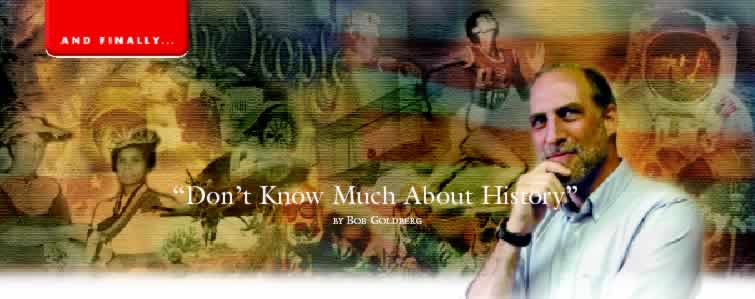| Vol.
13. No. 1 |
Summer
2003 |

Most of us have
heard of the “Greatest Generation,” those who weathered the
storms of the Great Depression and World War II. Many of us are Baby Boomers,
born between 1946 and 1965. Other are part of the cynical and worldly
Generation X—arriving between the mid ’60s and the early ’80s—raised
in the wreckage of Vietnam, Watergate, and Reaganomics. Each of these
generations has lived in interesting times. The drumbeat of history was
loud in their ears and they knew its power personally.
Now comes Generation Y—the younger brothers and sisters of Generation
X. The first wave, born in 1984, stormed university campuses this past
fall. Each year, in preparation for the annual onslaught, Beloit College
in Wisconsin publishes a “Mind Set List” that sheds light
on the experiences of the entering class. For Generation Yers, a southerner
has always been president of the United States. To them, Moscow was never
the capital of the evil empire. That honor goes to a place in some galaxy
far, far away. Cyberspace has always existed; apartheid never has.
This is a generation that lives briefly in the present but mostly in anticipation of the future—which means they just “don’t know much about history.” World War I and the Civil War are lost in the fog of time. The dole, brinksmanship, generation gap, and race card are not in their vocabularies. The American Revolution was, “like,” a tax problem.
Last fall, I crouched in the trench as the wave of Generation Yers hit campus. My post was History 1700, American Civilization—a required history survey class that enrolls 200 students. The first day, I looked out and saw their sullen faces. They were annoyed about taking a required course and convinced that they had been through this before. They were the walking wounded—casualties of high school history teaching that equates learning with memorization and knowledge with test scores. I began class with a question: Why is history important? One student replied, “It’s not. It’s about dead people, not about me.” The applause was deafening.
“Well,” I responded, “I see dead people. I hear dead people. And so will you.” My job is to raise the dead—with passion— and enable students to listen in on their conversations, understand their ideas, and observe their deeds. Thus, I take them back in time to a Puritan village in colonial New England. We walk the streets, visit the church, and look in the windows of the houses. We feel the tightness of their social life in a “howling wilderness” thousands of miles from their English home. We learn why they came to the New World and gain insight into America’s sense of exceptionalism and mission.
We go back in time to a southern plantation and bear witness to the closed world of slavery. We can sense the always implicit threat and sometimes very real lash of violence that seared the air of this factory in the field. The scars of slavery did not heal with emancipation but continue to mark both white and black minds in our present.
In the 1930s, we huddle together and shuffle forward on a bread line, students feeling the numbing power of poverty and the social and psychological damage wrought by depression. While there, I conjure up President Franklin Roosevelt’s sense of bewilderment at the rush of time. He said: “Never in my life have I seen things moving in the world with more cross currents or with greater velocity.” I identify with Roosevelt, I tell my students, because I felt a similar anguish in 1968 during the rapid-fire nature of events—the Tet Offensive in Vietnam, the murders of Martin Luther King Jr. and Bobby Kennedy, the confrontation at the Democratic Convention in Chicago. So, too, can Generation Yers identify with Roosevelt. On 9-11, they received their baptism in history. In such tragedies, we feel community not only with the living but the dead. History is important.
Yet what has been drilled into their heads is history as a pile of unrelated facts dispensed in discrete bits to fit the contours of a multiple-choice exam. This obscures the rhythms of the past. By making the past personal, a story of real women and men, students come to think in terms of patterns, ebbs, and flows.
The dead may literally make history, but the living must interpret the meaning and significance of past experiences. Metaphorically, history is a jigsaw puzzle consisting of thousands of pieces—some missing, some worn, others broken— that can be fitted into a coherent whole. The result of this piecing-together is a picture that changes hue and shape depending upon the time and angle viewed. I have found that students, when given the chance, can find solutions to the puzzle and treat historical material with imaginative insight.
At the end of our semester
together, Generation Yers own their past—and know a lot about history.
If the history of America has been the struggle to realize its ideals,
then they now see that this struggle is theirs—a property not of
the past and the dead, but the present, the future, and the living.
—Bob Goldberg is professor of history at the U.
